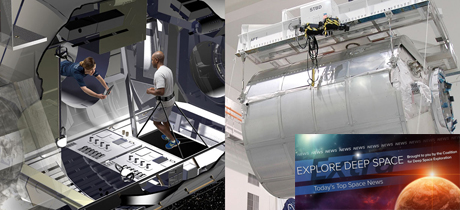In Today’s Deep Space Extra… NASA’s public/private NextSTEP collaboration with Lockheed Martin will repurpose a space shuttle cargo module into an elaborate ground based mockup of a possible deep space habitat.
Human Space Exploration
Shuttle-era cargo module to become deep space habitat prototype
Collectspace.com (7/24): A former but unflown module for the delivery of cargo to the International Space Station aboard NASA’s Space Shuttle has a new mission. Donatello, fabricated by the Italian Space Agency, is to be remodeled into a prototype habitat for astronauts in deep space, perhaps part of the lunar orbiting Deep Space Habitat that NASA is planning. Donatello will be outfitted in its new role at the Kennedy Space Center by Lockheed Martin. Lockheed will also fashion a Deep Space Avionics lab in Houston as part of the same venture, a NASA NextSTEP collaboration. Other NASA NextSTEP habitat partners include Bigelow Aerospace, Boeing, NanoRacks and Orbital ATK and Sierra Nevada.
The Space Review (7/24): Two U.S. private sector space enthusiasts, SpaceX’s Elon Musk and Robert Bigelow of Bigelow Aerospace, offered endorsements for a human return to the moon in remarks last week before the International Space Station Research and Development Conference in Washington D.C. Musk’s remarks were perhaps the most surprising because of his well-publicized focus on Mars. However, even a U.S. shift in focus back to the moon as a next destination on the way to Mars may not come easy, writes TSR editor Jeff Foust.
Russia’s post-ISS plans a mystery at best
Space News (7/24 online, 7/17 in print): Remarks by Igor Kamorov, head of Roscosmos, budget cuts, technical limitations and chilled relations with the West are among indications in recent months that Russia may be turning away from current partnerships in space and that Moscow may decide to separate its modules from the International Space Station in 2024. China and Russia also appear to be discussing a possible collaboration on Beijing’s new space station.
NASA television coverage set for next International Space Station crew launch
NASA (7/21): NASA’s Randy Bresnik, the European Space Agency’s Paolo Nespoli and Russia’s Sergey Ryazanskiy are set to liftoff from the Baikonur Cosmodrome in Kazakhstan on Friday at 11:41 a.m., EDT, for the International Space Station. Their scheduled docking at 6 p.m., will return the space station to six person operations for the first time since early June.
Governor Walker, Jim Lovell: Wisconsin remembers Apollo era, looks to future of space exploration
Right Wisconsin (7/20): The Experimental Aircraft Association will host a salute to NASA’s Apollo program on Friday, July 28. Buzz Aldrin, Frank Borman, Joe Engle, Dick Gordon, Fred Haise, Jim Lovell, Al Worden, and iconic flight director Gene Kranz will discuss their experiences and talk about America’s future in space as part of the annual Oshkosh, Wis., air show.
Space Science
The moon’s interior could contain lots of water, study shows
Space.com (7/24): A Brown University led study of volcanic material laced across the lunar surface suggests that moon’s interior may hold a lot of water, a resource that could be converted into liquid oxygen and hydrogen rocket propellants as well as used for life support needs. The water was likely borne of the solar wind and delivered early in the moon’s history, according to the study published Monday in the journal Nature Geoscience. The detections were made with sensors aboard India’s India’s Chandrayaan-1 lunar spacecraft mission.
Another view on the problems facing NASA’s Mars Exploration Program
The Space Review (7/24): In an op-ed, Louis Friedman, the Planetary Society’s director emeritus, expresses concern that policy makers may have jeopardized a necessary collaboration between the future human and robotic exploration of Mars. He questions plans to cancel NASA’s Asteroid Redirect Mission, which was to robotically collect a boulder from the surface of an asteroid and place it in lunar orbit as a destination for Orion astronaut. He worries about the Mars sample collection and caching assignment handed NASA’s Mars 2020 rover. Congress may not go along since there is no solid plan to retrieve the samples and return them to Earth, he writes.
Other News
Russian super-heavy booster vehicle to bring payloads of 70 tons to orbit
TASS of Russia (7/25): Russian bid documents indicate plans for a 70 ton to orbit super heavy launch vehicle at the new Vostochny launch complex, with flight tests a decade away. By comparison, NASA’s Block 1 Space Launch System is to boost 70 metric tons, enough to place an Orion capsule with astronauts into cislunar space.

